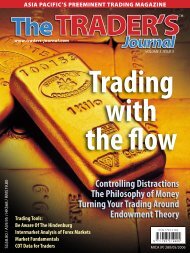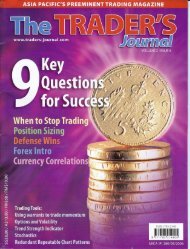The MACD
Our article about MACD Momentum (PDF) - 2hedge
Our article about MACD Momentum (PDF) - 2hedge
- No tags were found...
Create successful ePaper yourself
Turn your PDF publications into a flip-book with our unique Google optimized e-Paper software.
TECHNICAL ANALYSISRON SCHELLING<strong>The</strong> <strong>MACD</strong>Momentum OscillatorRon Schelling discusses how to interpret the MovingAverage Convergence/Divergence (<strong>MACD</strong>) indicator20 DECEMBER 2007 / VOL. 3 ISSUE 12
<strong>The</strong> moving average convergence/divergence (<strong>MACD</strong>) isa popular indicator used by many traders and analysts.Most charting software contains Gerald Appel’s <strong>MACD</strong>indicator.<strong>The</strong> standard indicator is composed of two lines. <strong>The</strong> <strong>MACD</strong>line is the difference between two exponential moving averages,typically the 12-period and 26-period exponential moving averages.<strong>The</strong> signal line or the trigger is an exponentially smoothedmoving average, usually the 9-period exponential moving averageof the <strong>MACD</strong> line and is often displayed as a dotted line.Signals often lag when used on weekly data and can cause lateposition entries and exits.On shorter length moving averages, there are more signals basedon price turns, while we like to use the <strong>MACD</strong> to indicate atrend change.In this article, I am looking for signals to confirm and anticipatetrend changes.To make things more easily visible, I will look at the <strong>MACD</strong>histogram.A histogram is a chart style that reflects changes in the indicatoras individual vertical lines above and below the zero line.For this study, the <strong>MACD</strong> line is the difference between the 10and 20-day exponential smoothed moving averages of price andthe <strong>MACD</strong> histogram is the difference between the <strong>MACD</strong> lineand its 10-day exponential moving average.It is often easier to see changes develop when using a histogramrather than the usual solid line style.<strong>The</strong> <strong>MACD</strong> histogram ismore than just a visual change in line style because it actuallymeasures the difference or space between the <strong>MACD</strong> line andthe trigger line.While the <strong>MACD</strong> line is lagging, the <strong>MACD</strong> oscillator is a leadingindicator.When the histogram crosses the zero line, it is an indication ofa change in the trend. <strong>The</strong> <strong>MACD</strong> oscillator gives the actualbuy/sell signal, a leading indicator.Interpreting the <strong>MACD</strong> momentum oscillator depends onwhether daily or weekly is used. When trading with weeklycharts, the most important consideration is the whether the indicatoris rising or falling.<strong>The</strong> second consideration is to look for the crossover above orbelow the zero line, signaling a possible upcoming buy or sellsignal.<strong>The</strong> third and final consideration is whether the indicator isdeeply oversold or overbought in relation with the <strong>MACD</strong> histogram.DECEMBER 2007 / VOL. 3 ISSUE 1221
TECHNICAL ANALYSIS22 DECEMBER 2007 / VOL. 3 ISSUE 12
On this chart, the <strong>MACD</strong> histogram is in the middle of thechart while the <strong>MACD</strong> momentum oscillator is at the bottomof the chart.Both indicators move above and below their own zero line.<strong>The</strong> <strong>MACD</strong> momentum oscillator is a leading indicator andoften gives a signal first before the legging <strong>MACD</strong> histogramsfollows.This strongly depends on which timeframe is used.As the chart shows, on daily data the <strong>MACD</strong> histogram is slightlyfaster. <strong>The</strong> official signal occurs when indicators cross in thesame direction.In this chart, we are looking at the popular Exchange TradedFund QQQQ with daily bars and using the same strategy.At the end of August, the <strong>MACD</strong> histogram in the middle chart,crossed the zero line while the confirmation came late from the<strong>MACD</strong> momentum oscillator on the 1st of September and bothindicators remain above the zero line until the end of October.After that period, both lines are clearly heading south.This weekly chart shows the exchange-traded fund, USO, whichrepresents the price of crude oil. As previously mentioned, leadingand lagging characteristics of the indicator depends on thetimeframe that is used.In this example, the <strong>MACD</strong> momentum oscillator is shownabove the zero line at the bottom of the chart for the whole year,while the <strong>MACD</strong> histogram is lagging and turned above its zeroline halfway through February.Even more importantly, both lines stay above their zero line sinceFebruary! Look at the <strong>MACD</strong> momentum indicator strength inOctober.<strong>The</strong> <strong>MACD</strong> momentum seems to produce more reliable signalswhen used with weekly data rather than with daily data.It also should be used in combination with other indicators likethe regular <strong>MACD</strong> and Bollinger Bands.Conclusion<strong>The</strong> <strong>MACD</strong> momentum oscillator generally serves as a leadingindicator, while the histogram of the <strong>MACD</strong> acts to confirm thechange in momentum. However, this is depends on whether thedata is daily or weekly.Both indicators must be moving in the same direction crossingthe zero line to have a valid signal.Ron Schelling is an independent trader from <strong>The</strong> Netherlands with over20 years experience in Forex, futures and arbitrage trading. He can bereached at www.2hedge.com.DECEMBER 2007 / VOL. 3 ISSUE 1223
Every issue of the trader’s journal brings you the latest and most detailed informationDO YOU HAVE ATRADINGEDGE?ASIA PACIFIC’S PREEMINENT TRADING MAGAZINEFeatures include...o Market Observations o Money Management o Interviews with Top Traders o Charting Techniques o Trading Psychologyo Charting o Options o Software reviews o Book Reviews o Charting Patterns o Trading Strategies o Intermarket Analysiso System Design o Indicators o Classic Techniques o Novice Trader o Statistics o Market Timingwww.tradersjournal.com





